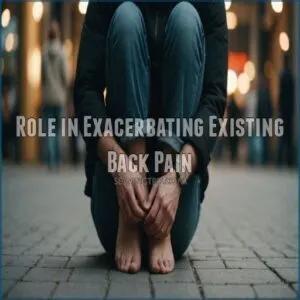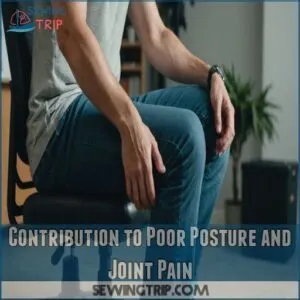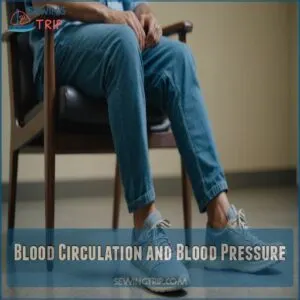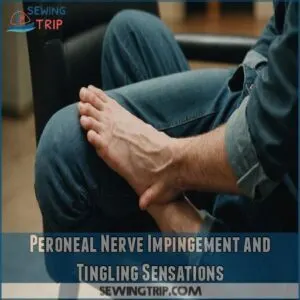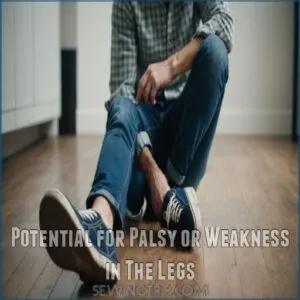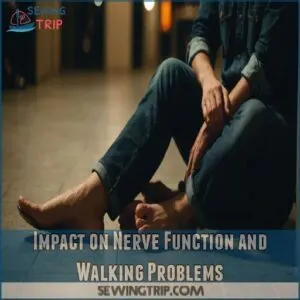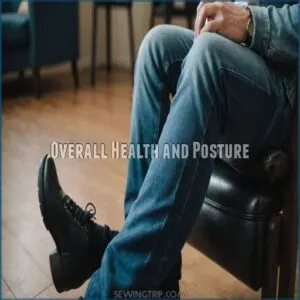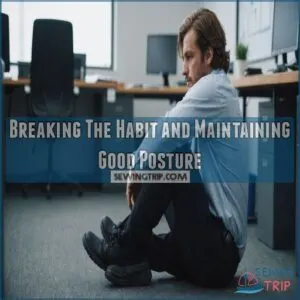This site is supported by our readers. We may earn a commission, at no cost to you, if you purchase through links.
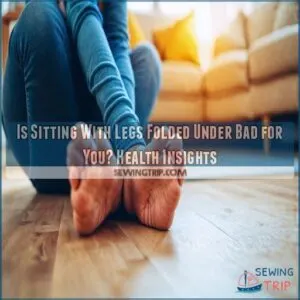 Sitting with your legs folded under might seem cozy, like your favorite sweater on a chilly day, but doing it often can cause some health hiccups.
Sitting with your legs folded under might seem cozy, like your favorite sweater on a chilly day, but doing it often can cause some health hiccups.
This position can put extra stress on your knees, especially if you’re lounging on that hard kitchen floor. It might mess with your posture and lead to joint pain. Plus, it could temporarily increase your blood pressure by compressing veins.
While it’s not a medical emergency, it’s wise to mix up your positions. Curious about how to sit comfortably while avoiding these pitfalls? Just imagine tuning into your body’s comfort signals for a start.
Table Of Contents
Key Takeaways
- Sitting with legs folded under can strain your knees and affect your spinal alignment, leading to poor posture and potential discomfort.
- This position might temporarily increase blood pressure and compress nerves, causing tingling or numbness.
- It’s not a medical emergency, but switching positions regularly helps maintain good blood flow and posture.
- Prioritizing comfort and proper sitting posture can reduce joint strain and enhance long-term health benefits.
Effects on Back and Posture
When you sit with your legs folded under, you might be tweaking your back in unkind ways that can throw your spine out of alignment, leading to discomfort or even scoliosis.
Over time, this habit can worsen existing back pain and cause poor posture, making your body feel like it’s in a never-ending tussle with gravity.
Impact on Spinal Alignment and Deformities

Ever wonder if crossing your legs messes with your spine?
Sitting cross-legged can affect your spinal alignment, leading to potential deformities.
These postural changes might trigger back pain and add stress to your pelvic alignment.
Imagine your posture like stacking blocks—misalignment rocks the stack.
So, keep an eye on your postural habits to maintain a healthy back!
Relationship Between Leg Crossing and Scoliosis

Crossing your legs might seem harmless, yet it can subtly affect scoliosis and spinal alignment.
Although not a direct cause, habitual leg crossing contributes to posture changes.
For designers and makers who spend a lot of time sketching and planning, utilizing tools like digital pattern making can help create more accurate and balanced designs.
Here’s what you should know:
- Scoliosis Risk Factors: Be mindful of posture habits.
- Static Posture: Favor balanced seating.
- Postural Alignment: Regularly adjust your sitting position.
These steps support spinal health without fuss.
Role in Exacerbating Existing Back Pain
That slouchy posture isn’t doing your back any favors!
If you already have back pain, sitting with your legs folded under can make it worse.
It throws your pelvis out of whack, stressing your spine.
Here’s a quick look:
| Sitting Position | Back Pain Impact | Posture Effect | Leg Circulation | Sciatica Risk |
|---|---|---|---|---|
| Legs folded under | Increased pain | Poor alignment | Reduced | Higher |
| Legs uncrossed, feet flat | Less pain | Neutral | Improved | Lower |
| Legs crossed at ankles | Mild pain increase | Slightly poor alignment | Slightly reduced | Mildly higher |
| Leaning back in chair | Can reduce back pain | Improves alignment | Neutral | Lower |
| Standing | Often reduces pain | Improves alignment | Improved | Lower |
Remember, posture correction is key for pain management!
Contribution to Poor Posture and Joint Pain
You’re noticing back pain, but the story doesn’t end there. Sitting with legs folded can lead to muscle imbalances and hip instability, causing joint strain and poor posture. This awkward sitting posture might also mess with your spine stability, leading to discomfort.
Consider these effects:
- Pelvic Misalignment
- Joint Pain
- Leg Numbness
- Muscle Imbalances
- Persistent Back Issues
Blood Circulation and Blood Pressure
When you sit with your legs crossed, it can obstruct veins, slowing blood flow and temporarily spiking blood pressure.
While these effects might sound alarming, they’re more likely to be a passing inconvenience than a health crisis, unless you’re already at risk for blood clots or hypertension.
How Leg Crossing Affects Vein Compression and Blood Flow
Ever wondered how sitting habits affect vein health?
Crossing your legs can compress veins, leading to circulation issues.
This increases the risk of blood clots or even deep vein thrombosis.
Keeping blood flow regular is like maintaining a good road network in your body—everything runs smoother.
It’s funny how a simple habit changes your body!
| Condition | Description | Impact |
|---|---|---|
| Vein Compression | Pressure on veins | Reduced blood flow |
| Circulation Issues | Slower movement of blood | Increased clot risk |
| Varicose Veins | Swollen veins due to poor circulation | Vascular strain |
Temporary Increase in Blood Pressure and Its Implications
Crossing your legs might give your blood pressure a small nudge upward, much like how a jog can raise your pulse.
This temporary spike isn’t usually a villain unless you’ve got underlying conditions or meds to take into account.
Here’s what to keep in mind:
- Short-term spikes can happen.
- Not likely to cause long-term harm.
- Individual risks matter.
- Consider medication interactions.
Risks of Blood Clots and Hypertension Due to Poor Circulation
While considering a temporary spike in blood pressure, it’s also worth noting how leg crossing can affect circulation.
Slow blood flow might lead to blood clots, especially deep vein thrombosis, causing leg swelling or spider veins.
During pregnancy, avoid crossing legs to improve blood flow.
Regularly monitor blood pressure to keep hypertension in check and prioritize blood clot prevention.
Nerve Compression and Sensory Issues
When you sit with your legs folded under, you might experience tingling due to pressure on your peroneal nerve, kind of like your leg’s way of saying, "Hey, pay attention!"
While this sensation is mostly harmless and temporary, ignoring it for too long could lead to temporary weakness or affect your walking stride, which isn’t the most graceful look.
Peroneal Nerve Impingement and Tingling Sensations
That restricted blood flow from sitting with your legs crossed can sometimes lead to more than just a bit of leg swelling.
You might experience a tingling sensation, a sign of peroneal nerve impingement.
This nerve, part of the sciatic nerve, gets squeezed, causing that uncomfortable pins and needles feeling.
Here’s what to watch for:
- Tingling in your lower leg or foot.
- Foot numbness.
- Mild leg pain.
- A general feeling of discomfort.
Usually, it’s temporary, but it’s a good reminder to give your legs a break!
Potential for Palsy or Weakness in The Legs
Feeling your legs go numb after sitting with them folded under you isn’t just a funny bone moment.
It might lead to nerve damage if prolonged.
Your peroneal nerve can get pinched, potentially causing palsy or weakness.
While serious issues are rare, avoiding this position can help reduce risks of leg length inequality and other long-term effects.
Impact on Nerve Function and Walking Problems
Imagining leg weakness and walking difficulties after a long sit might sound familiar.
Nerve damage from peroneal nerve compression can cause foot numbness and sciatic pain, which is why it’s important to address it with the right peroneal nerve compression relief.
Here’s what to watch for:
- Tingling or Pins and Needles – A temporary warning.
- Frequent Wristwatch Glances – Time for leg breaks.
- Awkward Footfalls – Signal for adjusting posture.
Varicose Veins and Pregnancy
You might worry that sitting with your legs crossed could cause varicose veins, but research shows that it’s not the culprit.
During pregnancy, it’s more important to focus on good circulation and addressing other factors like standing habits and weight management.
Debunking The Myth of Leg Crossing and Varicose Veins
Despite a common myth, crossing your legs doesn’t cause varicose veins.
The real culprits are factors like age, obesity, and genetics.
For pregnant women, maternity pants with stretch can help promote blood flow and comfort.
So, go ahead and sit comfortably!
Ditch the worry, and focus on movement and healthy habits instead.
Remember, sitting comfort and blood flow go hand in hand, so take those circulation tips seriously and switch positions regularly.
Importance of Maintaining Good Circulation During Pregnancy
How do you keep that blood flowing during pregnancy? Prioritize circulation to dodge those swollen ankles and varicose veins.
Slip on compression socks, try prenatal yoga, and incorporate gentle exercise into your routine.
Remember, even a seated leg twirl can boost blood flow—avoid folded legs, and keep comfy.
Aim for smart travel strategies, because circulation is key to your health.
Addressing Other Risk Factors for Varicose Veins
Concerning varicose veins during pregnancy, addressing other factors can help prevent them. Here’s what you can do:
- Lifestyle changes: Focus on weight management and staying active.
- Exercise routine: Keep it regular to support circulation, and consider using a vein support cream to aid in your overall vein health.
- Family history: Be aware of your genetic predispositions.
- Vein health: Elevate your legs to aid blood flow and reduce health risks.
Overall Health and Posture
You might think crossing your legs is harmless, but let’s explore how it affects your overall health and posture.
Maintaining good posture is key to feeling great and preventing long-term problems, so understanding how your sitting habits impact your body is important.
Why Crossing Legs is Not a Medical Emergency
You might wonder if crossing your legs is a medical emergency, but rest assured, it’s not.
While it might cause temporary discomfort and circulation myths abound, the posture impact is minimal.
Crossed legs can affect nerve health and blood flow legs, but it doesn’t spell doom.
Just be mindful, and enjoy the quirky comfort of your sitting position.
Benefits of Prioritizing Comfort and Adjusting Positions
While leg crossing isn’t a health concern, prioritizing comfort can work wonders for your sitting posture.
Similar to how engaging in a therapeutic hobby like sewing for relaxation can provide mental and physical benefits, shifting positions regularly can boost ergonomic benefits, improve circulation, and manage pain.
Think of it like adjusting the volume on your favorite song—keeps things just right.
This routine helps in reducing fatigue and preventing stiffness, making long-term sitting more pleasant and healthy.
Optimal Sitting Posture and Its Impact on Health
Exploring comfort brings us to your posture’s impact on health.
Aim for good sitting where ergonomic chairs make a difference.
Here are four tips:
- Ergonomic Chair: Support your back; it’ll thank you later.
- Posture Exercises: Boost strength and flexibility.
- Seated Stretches: Counteract long-term sitting.
- Healthy Habits: Adjusting your sewing area ergonomics, such as using a lumbar support cushion, can help reduce back pain. Reduce back pain by avoiding folded legs health issues.
Stay comfy!
Breaking The Habit and Maintaining Good Posture
Breaking the habit of sitting with your legs folded under you might seem tough at first, but your back and knees will thank you later.
Consider setting reminders to adjust your sitting position and seeking advice if you find it hard to make the change on your own.
Strategies for Avoiding Prolonged Leg Crossing
Want to break the habit of sitting with your legs crossed?
Use habit trackers and mindfulness practices to stay aware.
Try frequent movement breaks and adjust your desk setup for comfort.
Focus on chair ergonomics for support.
Remember, habits take time to change, but your back will thank you!
| Strategy | Benefits | Tools Needed |
|---|---|---|
| Movement Breaks | Improved Circulation | Timer, Reminders |
| Desk Setup | Better Posture | Ergonomic Chair |
| Habit Trackers | Consistency | Apps, Journals |
Tips for Maintaining Proper Posture and Reducing Discomfort
Recapping on strategies to avoid prolonged leg crossing, let’s shift focus to maintaining good posture.
Consider investing in an ergonomic chair solution to support your body, use ergonomic chairs to support your body, and take standing breaks to keep muscles active.
Practice mindful sitting by adjusting your office setup and incorporating back stretches.
By acknowledging folded legs pain and sitting posture, you’ll manage discomfort from long-term sitting and enhance crossed legs health.
Seeking Professional Advice for Habit Breaking
That stubborn leg-crossing habit got you down? Don’t worry, you’re not alone! Seeking professional help can be a game-changer. A physical therapist can offer personalized advice and habit breaking strategies. They can also suggest posture correction exercises and ergonomic solutions for long-term sitting.
- Find a qualified physical therapist.
- Discuss your specific needs and concerns.
- Work together to develop a personalized plan.
- Practice consistently for best results.
- Celebrate your progress along the way!
Frequently Asked Questions (FAQs)
What happens if you sit with your legs folded under?
Ever felt pins and needles sitting with your legs folded under?
You might pressure nerves and limit blood flow, which can cause discomfort or tingling.
Try shifting positions often to keep your circulation and posture healthy.
What can cause leg pain from a desk sitting job?
Sitting at a desk job might cause leg pain due to poor posture, prolonged sitting, and lack of movement.
Gravity causes blood pooling, leading to discomfort.
Regular breaks, stretching, and proper seating ergonomics can help alleviate pain.
Is sitting with one leg tucked under bad for You?
Perching like a stork by tucking one leg under you might seem comfy, but it can lead to poor posture and joint strain.
Alternating positions often to maintain comfort and promote better circulation and posture.
Is it bad to cross your legs while sitting?
Crossing your legs while sitting isn’t ideal as it can lead to poor posture, back pain, and temporary high blood pressure.
For better health, try to sit with both feet flat on the ground when possible.
Why is cross-legged sitting bad for You?
Let’s debunk that myth!
Constantly crossing your legs can strain your back, hinder blood flow, and even slightly raise your blood pressure.
It’s best to keep your legs uncrossed for better posture and circulation.
What are the negative side effects of sitting crossed legged?
Sitting cross-legged can put pressure on your joints, cause uneven hips, and lead to poor posture.
It might temporarily raise your blood pressure and cause tingling.
Changing positions frequently helps maintain comfort and good circulation.
Is it bad to sit with your legs tucked under you?
Ever wonder why sitting with legs tucked under you feels cozy but causes issues?
This position can lead to poor posture and circulation problems over time, so try to adjust your sitting habits to stay comfy and healthy.
Is it bad to sit with your legs folded?
Sitting with legs folded can be bad for you, as it may lead to poor posture, nerve compression, and decreased blood circulation.
It can potentially cause discomfort, numbness, and long-term health issues if done excessively.
Is it bad to sit with legs bent?
Imagine your body as a finely tuned machine.
Bending your legs while sitting can sometimes jam the gears.
It might lead to pressure on joints and poor circulation.
For comfort and health, stay mindful of posture.
What are the benefits of sitting with your feet tucked under?
Tucking your feet under can be comfy and grounding, especially when enjoying a cozy moment.
Some folks find it helps with focus or relaxation.
Just make sure to shift positions regularly to avoid stiffness or discomfort.
Does sitting with legs folded affect digestion?
Sitting with legs folded can slow digestion.
It restricts blood flow to your gut, potentially causing discomfort.
Try sitting with your feet flat on the floor for better digestion.
It’s a simple change with potential benefits!
Can sitting with legs folded impact mental focus?
Folding legs fosters focus flop!
While you’re comfy, poor posture can pinch nerves, slowing circulation and causing distraction.
Stay sharp by keeping your spine straight and feet flat.
Remember, changing positions can perk up your attention effortlessly.
Is there a cultural significance to leg folding?
Leg folding holds cultural significance worldwide.
In Japan, it’s tied to traditional practices like tea ceremonies, where seiza (kneeling) is common.
Many cultures view leg crossing or folding as respectful or meditative, illustrating diverse social meanings.
Does folding legs influence joint flexibility?
Crossing your legs might limit joint flexibility by putting uneven pressure on your knees and hips.
Over time, this pressure can reduce your range of motion, leading to stiffness.
Try shifting positions often to maintain flexibility.
How does folding legs affect energy levels?
Think of it this way: energy levels are like a battery.
Sitting with folded legs can hamper circulation, making you feel sluggish.
To boost energy, try changing positions frequently, ensuring better blood flow and preventing that mid-afternoon slump.
Conclusion
Imagine sitting for long hours with your legs folded under is a bit like bending a garden hose— the flow stops.
It might be cozy, but it can mess with your circulation, posture, and even nerve health.
It’s not an instant harm, but keep an eye on how your body feels.
Mix up your sitting styles and prioritize comfort to avoid these pitfalls.
So, is sitting with legs folded under bad for you? Maybe so—try switching it up!

